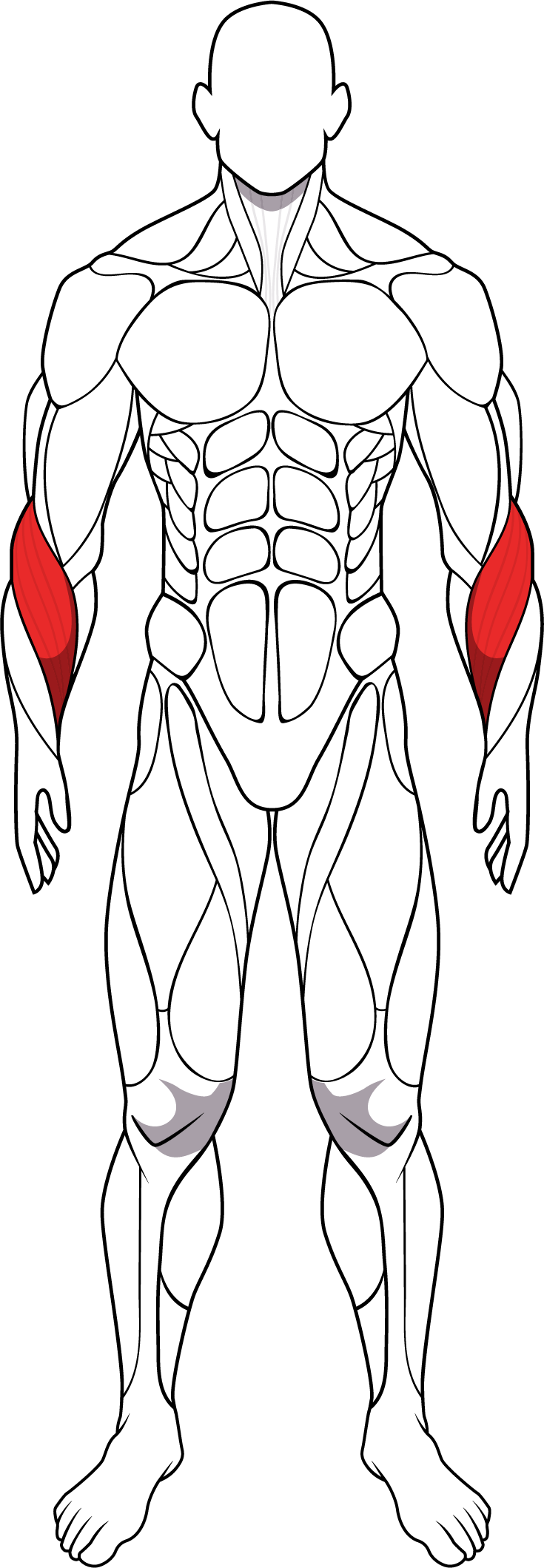The forearm muscles, also known as the antebrachial muscles, are a group of muscles located in the forearm region between the elbow and the wrist. These muscles play essential roles in controlling movements of the wrist, hand, and fingers, as well as providing stability and strength to the forearm and grip.
The forearm muscles, also known as the antebrachial muscles, are a group of muscles located in the forearm region between the elbow and the wrist. These muscles play essential roles in controlling movements of the wrist, hand, and fingers, as well as providing stability and strength to the forearm and grip.
The forearm muscles can be divided into two main groups based on their functions and anatomical locations: the flexors and the extensors.
Flexor Muscles:
Flexor Carpi Radialis: This muscle runs along the lateral (outer) side of the forearm. It originates from the medial epicondyle of the humerus (upper arm bone) and inserts into the base of the second metacarpal bone of the hand. The flexor carpi radialis primarily flexes the wrist joint and abducts the hand (moves it toward the thumb side).
Flexor Carpi Ulnaris: Located on the medial (inner) side of the forearm, the flexor carpi ulnaris originates from the medial epicondyle of the humerus and the posterior border of the ulna (one of the forearm bones). It inserts into the pisiform bone and the base of the fifth metacarpal bone of the hand. The flexor carpi ulnaris flexes the wrist joint and adducts the hand (moves it toward the little finger side).
Palmaris Longus: This muscle is absent in some individuals. It originates from the medial epicondyle of the humerus and inserts into the palmar aponeurosis (a thick band of connective tissue in the palm of the hand). The palmaris longus assists in flexing the wrist joint and tensing the palmar aponeurosis.
Flexor Digitorum Superficialis: This muscle lies deep to the flexor carpi radialis and flexor carpi ulnaris. It originates from the medial epicondyle of the humerus and the ulna and inserts into the middle phalanges of the four fingers (excluding the thumb). The flexor digitorum superficialis flexes the wrist joint and the proximal interphalangeal joints (the joints between the finger segments).
Flexor Digitorum Profundus: Also lying deep to the flexor carpi radialis and flexor carpi ulnaris, the flexor digitorum profundus originates from the ulna and inserts into the distal phalanges of the four fingers. It flexes the wrist joint and the distal interphalangeal joints (the joints closest to the fingertips).
Pronator Teres: This muscle is located on the medial side of the forearm. It originates from the medial epicondyle of the humerus and the coronoid process of the ulna, and it inserts into the radius. The pronator teres pronates the forearm (rotates it to face downward) and assists in flexing the elbow joint.
Extensor Muscles:
Extensor Carpi Radialis Longus: Located on the lateral side of the forearm, the extensor carpi radialis longus originates from the lateral epicondyle of the humerus and inserts into the base of the second metacarpal bone. It primarily extends the wrist joint and abducts the hand.
Extensor Carpi Radialis Brevis: This muscle lies deep to the extensor carpi radialis longus. It originates from the lateral epicondyle of the humerus and inserts into the base of the third metacarpal bone. Like the extensor carpi radialis longus, it extends the wrist joint and abducts the hand.
Extensor Carpi Ulnaris: Located on the medial side of the forearm, the extensor carpi ulnaris originates from the lateral epicondyle of the humerus and the posterior border of the ulna. It inserts into the base of the fifth metacarpal bone. The extensor carpi ulnaris primarily extends the wrist joint and adducts the hand.
Extensor Digitorum: This muscle originates from the lateral epicondyle of the humerus and inserts into the distal phalanges of the four fingers. It extends the wrist joint and the metacarpophalangeal joints (the joints between the hand and fingers).
Extensor Digiti Minimi: Located on the ulnar side of the forearm, this muscle originates from the lateral epicondyle of the humerus and inserts into the extensor expansion of the little finger. It extends the wrist joint and extends the little finger.
Supinator: Positioned between the flexor and extensor muscles, the supinator originates from the lateral epicondyle of the humerus and the ulna. It inserts into the radius and assists in supinating the forearm (rotating it to face upward).
In addition to the muscles mentioned above, various smaller muscles in the forearm assist in fine motor movements of the wrist, hand, and fingers. Strengthening and conditioning the forearm muscles through targeted exercises can improve grip strength, wrist stability, and overall upper limb function, making them essential for activities ranging from daily tasks to sports and weightlifting. Incorporating exercises such as wrist curls, reverse curls, grip exercises, and forearm rotations into your workout routine can help develop and maintain forearm strength and functionality. As always, it's essential to perform exercises with proper form and technique to minimize the risk of injury and maximize the benefits of training. If you're new to strength training or have any concerns, consider working with a qualified fitness professional to develop a safe and effective workout plan tailored to your goals and fitness level.
The forearm muscles can be divided into two main groups based on their functions and anatomical locations: the flexors and the extensors.
Flexor Muscles:
Flexor Carpi Radialis: This muscle runs along the lateral (outer) side of the forearm. It originates from the medial epicondyle of the humerus (upper arm bone) and inserts into the base of the second metacarpal bone of the hand. The flexor carpi radialis primarily flexes the wrist joint and abducts the hand (moves it toward the thumb side).
Flexor Carpi Ulnaris: Located on the medial (inner) side of the forearm, the flexor carpi ulnaris originates from the medial epicondyle of the humerus and the posterior border of the ulna (one of the forearm bones). It inserts into the pisiform bone and the base of the fifth metacarpal bone of the hand. The flexor carpi ulnaris flexes the wrist joint and adducts the hand (moves it toward the little finger side).
Palmaris Longus: This muscle is absent in some individuals. It originates from the medial epicondyle of the humerus and inserts into the palmar aponeurosis (a thick band of connective tissue in the palm of the hand). The palmaris longus assists in flexing the wrist joint and tensing the palmar aponeurosis.
Flexor Digitorum Superficialis: This muscle lies deep to the flexor carpi radialis and flexor carpi ulnaris. It originates from the medial epicondyle of the humerus and the ulna and inserts into the middle phalanges of the four fingers (excluding the thumb). The flexor digitorum superficialis flexes the wrist joint and the proximal interphalangeal joints (the joints between the finger segments).
Flexor Digitorum Profundus: Also lying deep to the flexor carpi radialis and flexor carpi ulnaris, the flexor digitorum profundus originates from the ulna and inserts into the distal phalanges of the four fingers. It flexes the wrist joint and the distal interphalangeal joints (the joints closest to the fingertips).
Pronator Teres: This muscle is located on the medial side of the forearm. It originates from the medial epicondyle of the humerus and the coronoid process of the ulna, and it inserts into the radius. The pronator teres pronates the forearm (rotates it to face downward) and assists in flexing the elbow joint.
Extensor Muscles:
Extensor Carpi Radialis Longus: Located on the lateral side of the forearm, the extensor carpi radialis longus originates from the lateral epicondyle of the humerus and inserts into the base of the second metacarpal bone. It primarily extends the wrist joint and abducts the hand.
Extensor Carpi Radialis Brevis: This muscle lies deep to the extensor carpi radialis longus. It originates from the lateral epicondyle of the humerus and inserts into the base of the third metacarpal bone. Like the extensor carpi radialis longus, it extends the wrist joint and abducts the hand.
Extensor Carpi Ulnaris: Located on the medial side of the forearm, the extensor carpi ulnaris originates from the lateral epicondyle of the humerus and the posterior border of the ulna. It inserts into the base of the fifth metacarpal bone. The extensor carpi ulnaris primarily extends the wrist joint and adducts the hand.
Extensor Digitorum: This muscle originates from the lateral epicondyle of the humerus and inserts into the distal phalanges of the four fingers. It extends the wrist joint and the metacarpophalangeal joints (the joints between the hand and fingers).
Extensor Digiti Minimi: Located on the ulnar side of the forearm, this muscle originates from the lateral epicondyle of the humerus and inserts into the extensor expansion of the little finger. It extends the wrist joint and extends the little finger.
Supinator: Positioned between the flexor and extensor muscles, the supinator originates from the lateral epicondyle of the humerus and the ulna. It inserts into the radius and assists in supinating the forearm (rotating it to face upward).
In addition to the muscles mentioned above, various smaller muscles in the forearm assist in fine motor movements of the wrist, hand, and fingers. Strengthening and conditioning the forearm muscles through targeted exercises can improve grip strength, wrist stability, and overall upper limb function, making them essential for activities ranging from daily tasks to sports and weightlifting. Incorporating exercises such as wrist curls, reverse curls, grip exercises, and forearm rotations into your workout routine can help develop and maintain forearm strength and functionality. As always, it's essential to perform exercises with proper form and technique to minimize the risk of injury and maximize the benefits of training. If you're new to strength training or have any concerns, consider working with a qualified fitness professional to develop a safe and effective workout plan tailored to your goals and fitness level.


